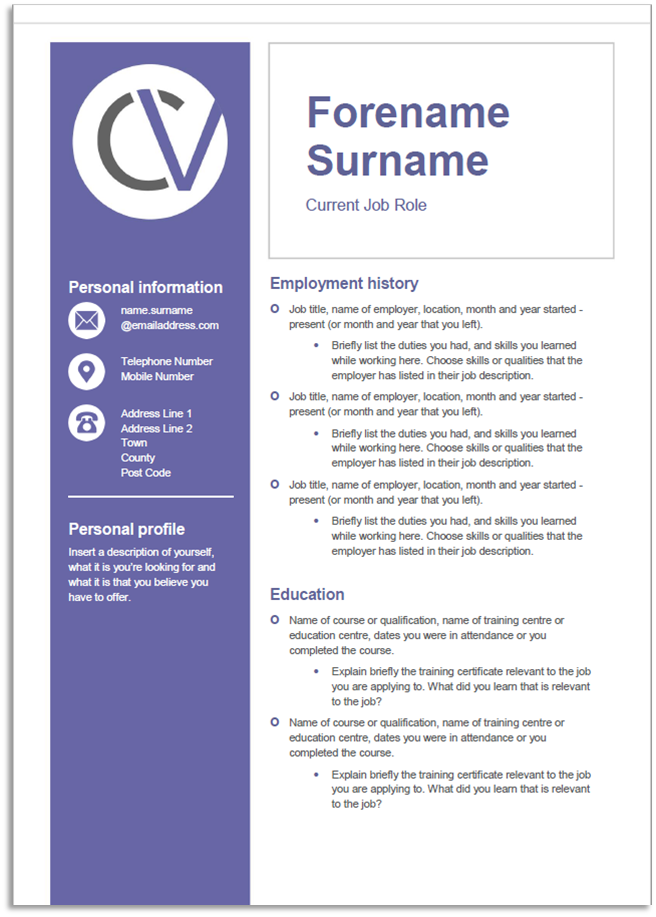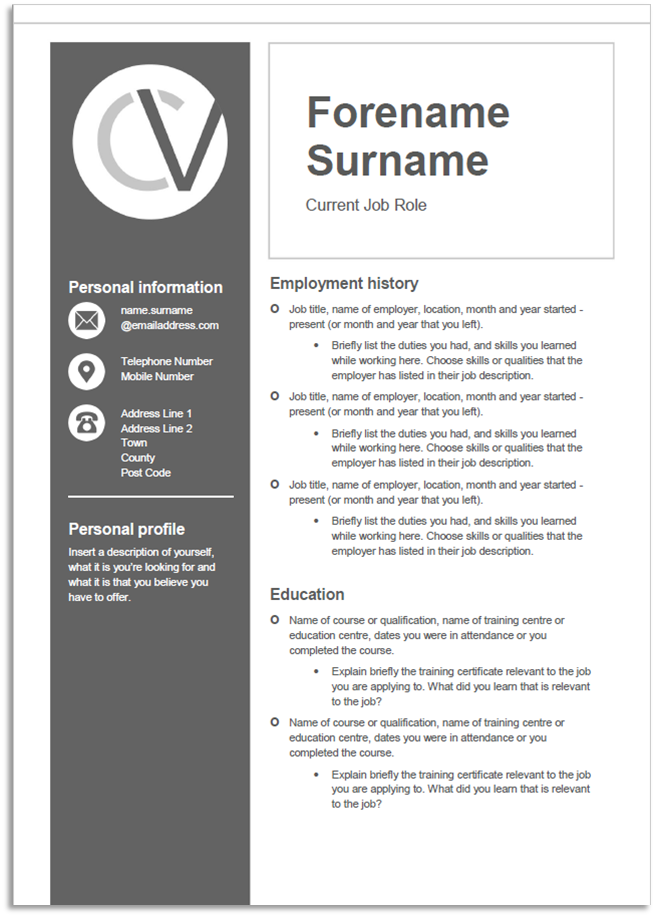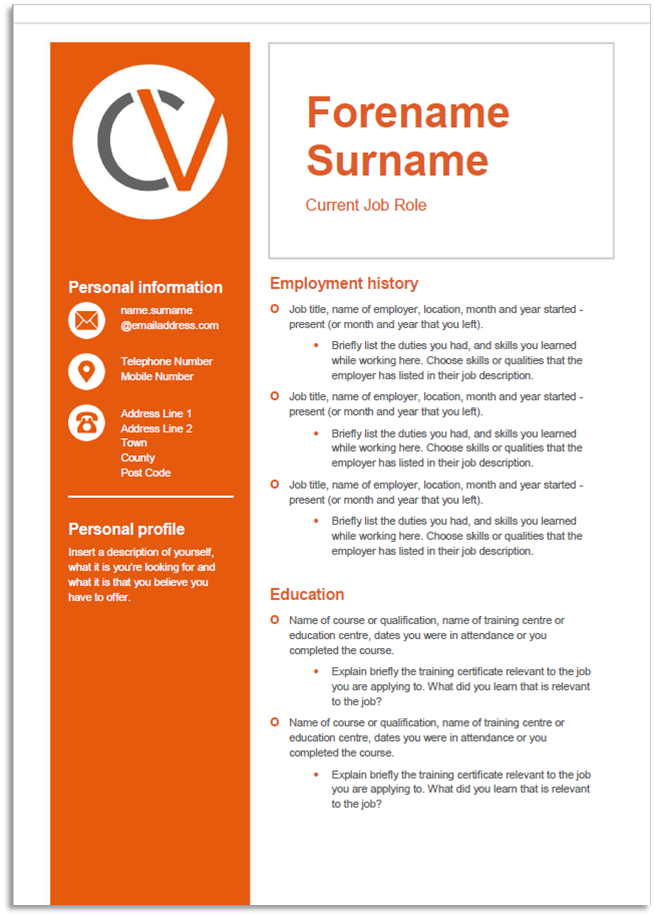With an increase in online shopping, the need for multi-drop drivers is increasing; so there are lots of job opportunities out there.
To land a job as a delivery driver, your CV needs to show that you’re self-motivated, have good problem solving skills, and have a car driving licence.
Whether you're looking to start your driving career or take the next step up the ladder, our free CV template is tailored to ensure your CV stands out from the crowd.
A guide to writing CV for a Delivery Driver job
Name: Connor Moran
Tel No: 0000 0000 000
Email: ConnorMoran@email.com
Address: 63 Grey Street
Northampton
NN19 9EX
Personal Profile
The personal profile is your chance to professionally introduce yourself, in three or four sentences, with relation to the job you’re applying to. Ideally this should include your current work situation, what type of work you are searching for (such as part-time, flexible hours, or full-time employment starting immediately) some key skills, traits or experience that will show the potential employer that you are a good candidate for the advertised job.
If you have a clean driving licence, knowledge of the local area you'll be working in, and experience working as a delivery driver, mention this here.
EXAMPLE:
I am a hard-working and reliable delivery van driver, with good knowledge of the local area and a clean UK driving licence. I am looking for a full-time job that will continue to improve my driving skills. I am self-motivated but also enjoy working with others in a team.
Work History
The work history section is to show the potential employer what jobs or work experience you’ve done. It is the first chance for you to highlight the skills and experience each one has given you, and this is turn should show why you are a good fit for the job you’re applying for. You don’t need to include every last detail, just pick the best parts. You can always write down and save your examples or other relevant skills for the interview.
- Job title, name of employer, location, month and year started – present (or month and year that you left)
- Briefly list the duties you had, and skills you learned while working here. Choose skills or qualities that the employer has listed in their job description
EXAMPLE:
- Delivery van driver, DHL logistics, Northampton, March 2017 – present
- Responsible for maintenance of my van, completing delivery paperwork, recording mileage, and carefully loading/unloading goods.
- I have learned how to effectively plan my route, adhere to current safety requirements, and have a good knowledge of the local area and road networks
What jobs should you include?
- Include your work history for the last five years. If you haven’t been working for that long, that is okay. It will be explained by the education history. If you have recently moved to the country, it’s okay to include employment in other countries. There is more advice on work and education history in our top tips online article.
- If you’re applying for your first role in this sector, it’s still important to include your work history. Use it to highlight relevant skills that the employer is looking for, such as organisation, team work and good communication.
- Include details of any jobs that have involved driving, even if it’s the organisation’s car – this still shows you are responsible and a driver than a potential employer can trust.
Education History
In education history, this is a chance to show any relevant training you have completed, what skills you have learned from your courses, as well as general education subjects you’ve passed. If you have completed courses or gained certificates relating to work, include that information here. As you get more work experience, this section will become shorter, as your work history becomes more relevant and more recent.
The most important thing you need to work as a delivery driver, is a car driving licence, which allows holders to drive a van that is less than 3.5 tonnes. If you don't have a drivers licence, you can find out more about getting one here. A good level of English and Maths is also desirable.
- Name of course or qualification, name of training centre or education centre, dates you were in attendance or you completed the course.
- Explain briefly the training certificate relevant to the job you are applying to. What did you learn that is relevant to the job?
EXAMPLE:
- First Aid, Yorkshire Driver Training, October 2016
- Completed a one-day course in emergency first aid at work, level 2
Skills
Here is your chance to highlight the best skills you have in relation to the driving job you’re applying for. Hint: these will be the skills listed in the job advert, but be careful to only highlight the skills you have. False information on your CV is likely to trip you up in an interview and is unprofessional; you don’t have to show you have every skill listed in the job advert to be successful.
EXAMPLE:
- Driving and concentration – ‘From taking on longer routes I have improved my practical van driving skills and ability to stay focused on the road for long periods of time. I always take the most direct and safest route, and am confident in any road situation.’
- Communication and team skills – ‘From liaising with customers about deliveries, and my manager, I have improved my listening and communication skills. I can now easily discuss problems with colleagues and customers, and work as a team towards finding a solution.’
References
First and last name
Job title and relation to you in the work place (if it isn’t obvious from the job title), name of work place, work contact number (or main company phone number which they can be reached through) and work email address.
EXAMPLE:
Alex Smith
Supervisor, DHL Logistics, Northampton
0000 0000 00
alexsmith@email.com
Who should you include as a reference?
- Your first reference should ideally be from your current or most recent manager or supervisor. The second reference can be from a current colleague, or line manager or supervisor from a previous job. It’s best practice to ask someone if they will be a reference for you before they are contacted. Be aware that not all employers actually contact references, but it’s important to have them available if needed.
- It’s important to remember that while you are in your current job, consider that you may not want your reference (eg. your current head chef/boss) to be contacted until you have had an interview for a new possible job, or are actually offered it. This is because, for instance, if you weren’t offered the new job, and end up staying in your current job then you might not want your manager having been contacted as a reference. It can cause tension or awkward conversations about why you were trying to leave. A good way to get around this is to simply write ‘References available on request’. This shows the new employer that they can ask you for them as needed, but also means you can ask them to only contact them if you are offered the job, and then have time to ask the reference if it’s okay for them to be contacted. Most potential employers will be happy to wait to do this after offering you the job.
- If you have only had one previous job, or have been studying, it is okay to include a tutor as a reference, or someone else as a character reference (who is not related to you).





